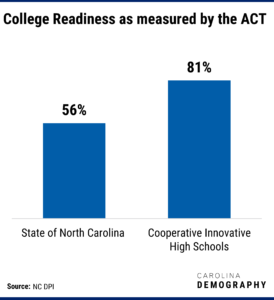Cooperative Innovative High Schools: A Guide

Adaeze Ibeanu is a rising sophomore at UNC double majoring in Psychology and Political Science. She recently started interning with Carolina Demography, where she has been monitoring legislative committee meetings that address education in North Carolina. She will continue this work when the General Assembly convenes for the long session in January. Most recently, she has researched and written a blog post about Cooperative Innovative High Schools in NC – one of which she attended in Durham.
Found across the state, Cooperative Innovative High Schools (CIHS) are public schools that allow students to enroll in higher education while simultaneously completing high school requirements. CIHS’s typically target at risk students, first-generation college students, and/or “students who would benefit from accelerated learning opportunities.” Upon graduation, students typically receive a high school diploma and either an associate degree, a certificate, or transferrable college credits. Attending a CIHS prepares students for college coursework and ultimately, helps reduce the cost associated with higher education.
Originally funded by the Gates Foundation and the General Assembly in 2004, CIHS’s have grown and North Carolina has become a leader of the model across the nation. With a cap of 100 students per grade level, CIHS’s allow for a small student to teacher ratio and more individual student attention. Individual student attention is crucial in helping with the retention and graduation rates.
Currently, North Carolina has 132 CIHS’s across the state. As of 2019, there were 27,001 students attending Cooperative Innovative High Schools (CIHS) out of 431,499 public high school students, which is approximately 6% of students across the state.
Tyrrell, Hyde, Madison, Northampton, and Camden are the five NC counties with the largest percentage of CIHS students.

The CIHS FAQ on the NC Department of Public Instruction (DPI) website notes that in the 2018-19 school year:
Attending a CIHS was a unique experience that I was fortunate to be afforded. I attended an early college that was partnered with a four-year university rather than a technical college, so although I did not graduate with an associate’s degree, I did amass a number of credits equivalent to two years of college coursework.
Because CIHS’s are notoriously rigorous, there is a heavy emphasis on getting new students acclimated to the climate. My school did this in the form of an intense freshman orientation; we spent an entire week together before the start of the school year learning about helpful habits and learning more about our cohort. There the faculty and administration stressed that our coursework from then on would be harder than we had previously experienced. Though we felt daunted about what was to come, but it did help ease the adjustment period.
More than getting us ready for our experience to come, the most important lesson we learned was camaraderie. It would be only the 100 of us from that point on until graduation; no transfers or new students would enter the cohort. The small class size encouraged close peer relationships and built the foundation of teamwork that would aid us in postsecondary education.
In the four years of high school at my CIHS, our schedule emphasized completing college courses, thus we only took the required high school courses necessary for graduation and started taking college courses in the ninth grade. Because we were partnered with a four-year university, the amount of courses we were allowed to register for were endless and we were given the freedom to take courses that appealed to us. I took many math and political science courses, so I found myself specializing in those subjects. An appealing aspect of my high school were the freedoms. The freedoms associated with college, particularly the attendance policy, scheduling, and ability to develop our passions, also belonged to us. The campus and its classrooms were our oysters and we high school students were its pearls. We would sit side by side with students well into their college careers and be treated just the same. We were granted the opportunity to learn from professors with the highest degrees and conducting research in the field they were teaching.
While it was a great experience, we were often reminded that other students did not have the opportunity to attend such academically driven schools. In a county with thousands of students in each grade level, only 400 students per year were able to attend CIHS’s. Due to many families wanting to place their children in CIHS’s, lotteries and caps are implemented. I find it difficult to accept that students are denied simply because of chance. College readiness should not be determined by which schools you attend. Looking to the future, I hope to see the implementation of certain CIHS’s policies in traditional public schools and the improvement of student and teacher welfare in all schools.
Need help understanding population change and its impacts on your community or business? Carolina Demography offers demographic research tailored to your needs.
Contact us today for a free initial consultation.
Contact UsCategories: Education

The Center for Women’s Health Research (CWHR) at the University of North Carolina School of Medicine released the 12th edition of our North Carolina Women’s Health Report Card on May 9, 2022. This document is a progress report on the…

Dr. Krista Perreira is a health economist who studies disparities in health, education, and economic well-being. In collaboration with the Urban Institute, she recently co-led a study funded by the Kate B. Reynolds Foundation to study barriers to access to…

Our material helped the NC Local News Lab Fund better understand and then prioritize their funding to better serve existing and future grant recipients in North Carolina. The North Carolina Local News Lab Fund was established in 2017 to strengthen…
Your support is critical to our mission of measuring, understanding, and predicting population change and its impact. Donate to Carolina Demography today.